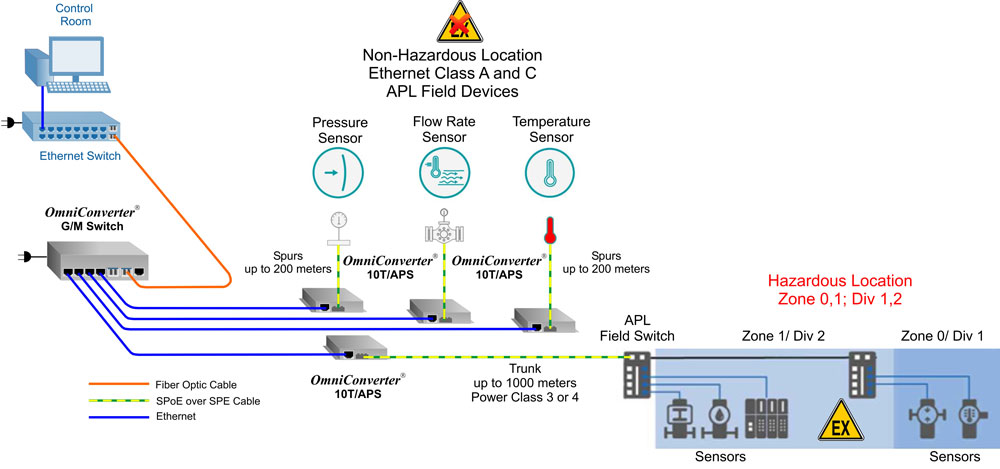Main Menu
Useful Links
Contact us
Follow us
© 2025 Omnitron Systems Technology, Inc. All Rights Reserved. | Privacy Policy
Industrial Process Automation
For applications where the industrial processing sensors exceed the copper Ethernet distance from the Environmental Control Room, an OmniConverter G/M Ethernet switch can be used to extend a fiber connection to within the copper distance of the sensors. The OmniConverter G/M extends a 10Mbps Ethernet copper connection to the 10T/APS, where the 10T/APS converters connect to the industrial processing sensors using SPE cabling. Three Ethernet APL Field Devices are connected up to 200 meters across a spur connection in a non-hazardous area. A fourth 10T/APS converter extends a trunk connection up to 1000 meters to an APL Field Switch in a hazardous area.

| OmniConverter 10T/APS | |
|---|---|
| Model Number | Description |
| 2022-c0-19Z |
10T/APS - 1 x 10BASE-T RJ-45 and 1 x 10BASE-T1L APL, TL1/PSE 1.0V, Class A, Direct DC input, Extended temperature (-40 to 75°C) |
| 2024-c0-19Z |
10T/APS - 1 x 10BASE-T RJ-45 and 1 x 10BASE-T1L APL, TL1/PSE 1.0V, Class C, Direct DC input, Extended temperature (-40 to 75°C) |
| 2025-c0-19Z |
10T/APS - 1 x 10BASE-T RJ-45 and 1 x 10BASE-T1L APL, TL1/PSE 1.0/2.4V, Class 3, Direct DC input, Extended temperature (-40 to 75°C) |
| 2027-c0-19Z |
10T/APS - 1 x 10BASE-T RJ-45 and 1 x 10BASE-T1L APL, TL1/PSE 1.0/2.4V, Class 4, Direct DC input, Extended temperature (-40 to 75°C) |
| 0 = 3-pin Terminal |
| 2 = IEC 63171-2 SPE jack |
| 1 = With integrated mounting brackets |
| 9 = Direct DC input with 2-Pin Terminal Connector, no AC/DC Power Adapter |
| Z = Extended temperature (-40 to 75°C) |
OmniConverter 10T/APS Single Pair Ethernet (Data Sheet)
OmniConverter 10T/APS Single Pair Ethernet (User Manual)
10T/APL
The OmniConverter 10T/APS Single Pair Ethernet converters are 10BASE-T1L products that convert 10BASE-T Ethernet to 10BASE-T1L Ethernet. They are designed for digital instrumentation solutions used for industrial control processes. They utilize single-pair Ethernet cabling (SPE) to extend the Ethernet link distance up to 200 or 1000 meters depending on the model number.
The 10T/APS converters feature one 10BASE-T1L 3-pin terminal or IEC 63171-2 port and one 10BASE-T RJ-45 port supporting 10Mbps full-duplex data rates.
Omnitron 10T/APS converters are interoperable with Ethernet-APL Class A, C, 3 and 4 edge/field devices and act as a Power Source capable of delivering up to 56 watts, depending on the model number. The 10T/APS models 2022 and 2024 support 1.0V peak-to-peak signal amplitude voltage when connecting to Class A and C edge/field devices. Whereas the 2025 and 2027 models use Automatic Link negotiation to transmit 1.0V or 2.4V peak-to-peak signal amplitude voltage to the field /edge devices.
The following are the product configurations.
| Product Name | Base Model # | Port 1 | Port 2 | |
|---|---|---|---|---|
| 10T/APS | 2022 | 10BASE-T | T1L/PSE 0.5W | Class A (1.0V) |
| 10T/APS | 2024 | 10BASE-T | T1L/PSE 1.0W | Class C (1.0V) |
| 10T/APS | 2025 | 10BASE-T | T1L/PSE 36W | Class 3 (1.0V/2.4V) |
| 10T/APS | 2027 | 10BASE-T | T1L/PSE 56W | Class 4 (1.0V/2.4V) |
The 10T/APS converters are interoperable with Ethernet-APL Field Devices. The converters can connect to a spur or trunk segment.. A Spur segment has a maximum distance of 200 meters and data signal amplitude of 1.0 volt peak-to-peak. A Trunk segment has a maximum distance of 1000 meters and data signal amplitude of 2.4 volts peak-to-peak.
They are available as standalone units with integrated mounting brackets. They can be DIN-rail mounted using the optional DIN-rail mounting clip kit (8252-0). Models come with a 2-pin DC power terminal connector.
Hazardous Area Use Disclaimer: This product is not certified for use in hazardous (classified) locations, including Zone 0, Zone 1, or Zone 2 as defined by IEC 60079-10-1 or equivalent national standards. It is intended for installation in non-hazardous (safe) areas only. The product supports interoperability with Ethernet-APL networks and devices, including those installed in hazardous zones, provided that all connections are made through certified intrinsically safe interfaces as part of a compliant system architecture. When connecting to devices located in hazardous areas, appropriate energy-limiting devices, field switches, or barriers must be used to ensure compliance with all applicable safety standards. |
||||||||||||||||||||||||||||||||||||||||||||||||||||||||||||||||||||||||||||||||||||||